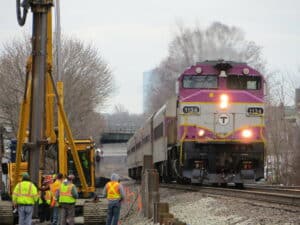Several MBTA commuter rail lines are getting more rush-hour service as data mounts that commute problems are a leading cause of Boston-area workers reluctance to return to the office full-time.
T leadership and Keolis, the subsidiary of French national rail operator SNCF that’s contracted to run the T’s commuter rail service, said train frequency will increase on the Lowell, Fitchburg, Franklin, and Worcester lines during rush hour. But the changes won’t disrupt the “clockface” service plan adopted during the pandemic that’s help make traveling on the commuter rail more predictable throughout the day.
“We understand how the availability of mass transportation options affects how our riders choose to travel. This fall schedule balances the needs of our customers that rely on Commuter Rail for work, but also now better serves the public with additional late night trains,” MBTA General Manager and CEO Phillip Eng said in a statement.
Starting Oct. 2, trains inbound to Boston on those lines will come every 35 minutes between 6:25 a.m. and 8:40 a.m., and every 30 to 40 minutes in the other direction between 3:55 p.m. and 6:20 p.m. An express train is also being added to the Fitchburg Line, running from South Acton to Porter Square and North Station, Keolis said, and the Franklin and Foxboro lines will have “an entirely new schedule” that boosts service to Franklin during rush hour by an unspecified amount. Worcester Line passengers will also see an additional peak trip to and from Framingham, making stops at all stations between Framingham and South Station.
But Worcester riders are losing their express service to downtown Boston in an effort to add more service to outlying areas on that line. The Heart to Hub service will begin making local stops between Worcester and West Natick before running express to Boston Landing, Back Bay and South Station.
Schedule changes will also add late-night weekday and weekend service to nearly all lines, with some trains leaving as late as 11:55 p.m., nearly an hour later than they currently run.
“With this new schedule, passengers who work non-traditional hours or attend evening events in Boston can access extended late-night weekday and weekend service,” Abdellah Chajai, CEO of Keolis Commuter Services, said in a statement.
The changes come as some Greater Boston residents tell pollsters that they have lost faith in the T’s reliability, and downtown businesses signal that transit and driving problems are a major obstacle to getting employees to return to the office.
Business-backed transit and planning advocacy group A Better City conducted an informal survey of members in the spring, which found that commute problems and “morale and work-life balance” were far and away their biggest obstacles to bringing workers back full-time despite identifying a range of benefits they saw to increasing in-person work – chiefly collaboration, mentorship and “community connection.”
A new poll of 1,000 Boston-area residents by the MassINC Polling Group released Wednesday found substantial pessimism about the state of the T.
While nearly 2 in 5 said commuter rail service was “good” and another 8 percent rated it as “excellent,” those shares were nearly reversed when it came to the MBTA’s bus system – 13 percent said it was “poor” and 38 percent called it “fair,” while only 30 percent said it was “good” and 5 percent labeled it as “excellent.”
And nearly two-thirds of riders slammed the performance of the T’s subway lines, beset with slow and unreliable service, as either “poor” (27 percent) or “fair” (35 percent). Only 23 percent called it “good” and 5 percent said it was “excellent.”
Problems with the T’s services have dramatically dragged down ridership. With service on the T’s highest-capacity line, the Red Line, at 44 percent of its pre-pandemic maximum, ridership on the line is down to 39 percent of pre-COVID highs according to MBTA data analyzed by watchdog group TransitMatters. Orange Line ridership is at 44 percent of its historical maximum while Green Line ridership is at 56 percent and Blue Line ridership is at 65 percent. And the bus system only carries 52 percent of the riders it carried in December 2019.







